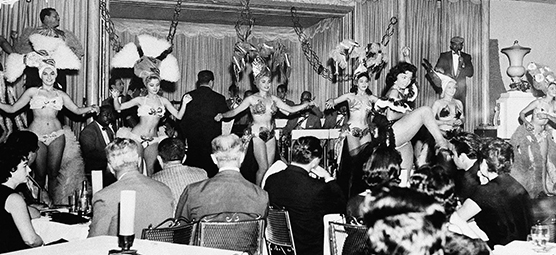The Havana conference
This year marks the 70th anniversary of one of the most famous meetings in Mob history


Mob meetings are tricky events to organize. Travel logistics aside, the conflicting personalities, territorial beefs, and ever-present threat of law enforcement bring a unique set of challenges. Because of those factors, major Mob gatherings were fairly uncommon in the history of American organized crime. When they did occur, however, they were historically significant events.
One of the largest Mob gatherings didn’t take place in New York or Chicago. It wasn’t even on America soil. It was in Cuba, and it would set the course for the island nation’s next decade as well as the evolution of the Mafia in the United States. The Mob already had tentacles in Cuba through Meyer Lansky and the Tampa crime family (first under Ignazio Antinori, then his successors, Santo Trafficante Sr. and Jr.). But this meeting would take that influence to the next level.
The Havana Conference of 1946 was organized by Charles “Lucky” Luciano, and brought together more than twenty mobsters representing crime families from New York to New Orleans and from Buffalo to Tampa. Luciano had recently arrived in Cuba from Italy, via South America (Luciano was deported to Italy in February 1946). Luciano wanted to address some pressing issues as well as show the U.S. mobsters that even though he was in exile, he still wielded enormous power.
The meeting took place the week of December 22, 1946, at the Hotel Nacional de Cuba, one of the finest of the Havana hotels. The attendees were chauffeured around town during downtime to the various nightclubs and casinos. The menu at the meeting, according to author Enrique Cirules in his book The Mafia in Havana, included “crab or queenconch enchiladas … tortoise stew, roast tortoise with lemon and garlic, crayfish from Cojimar, oysters from Sagua and grilled swordfish.”
There are conflicting reports of what exactly was on the agenda, but it’s clear that expansion of Mob operations in Cuba were front and center. There was also discussion of the Mob’s heroin and cocaine trade. Contrary to popular perception, the Mob was heavily involved in the narcotics trade, especially in the early to middle part of the 20th century. Cuba was one of the main transfer points to various U.S. port cities controlled by the Mob.

Another big topic was what to do about Las Vegas, specifically Benjamin “Bugsy” Siegel and his Flamingo Hotel. Siegel had been sent out to Las Vegas (he was living in Los Angeles at the time) to oversee construction of the new resort. When the budget swelled from $1 million to $6 million, some of his fellow mobsters, including his childhood friends Luciano, Frank Costello, and Meyer Lansky, were suspicious that Siegel, along with his mistress, Virginia Hill, were skimming off the top. According to fellow attendee Doc Stacher, Lansky passionately defended Siegel at the Havana meeting and asked that he be spared. (It was a temporary reprieve. The situation in Las Vegas continued to deteriorate after the Flamingo opened. Siegel was gunned down in his Beverly Hills home on June 20, 1947.)
The Havana conference ended on December 26, 1946. From there the Mob’s role in Cuba exploded. Gangsters from all over the country descended on the tiny island to run casinos and nightclubs, and expand their criminal empires. Luciano was deported from Cuba in 1947 after pressure from the U.S. government but Lansky remained a force, as did Tampa boss Santo Trafficante Jr., among other wiseguys.
But even that party didn’t last. The Mob’s role in Cuba ended on January 1, 1959, with the overthrow of Fulgencio Batista and the rise of Fidel Castro.
Conference attendees (based on various sources):
- Tony “Joe Batters” Accardo – Chicago
- Albert “the Mad Hatter, Lord High Executioner” Anastasia – New York
- Joseph Bonanno – New York
- Anthony “Little Augie Pisano” Carfano – New York
- Frank Costello – New York
- Moe Dalitz – Cleveland (later of Las Vegas)
- Giuseppe “Joe Adonis” Doto – New York
- Charles Fischetti – Chicago
- Rocco Fischetti – Chicago
- Vito Genovese — New York
- Phil “Dandy Phil” Kastel – New Orleans
- Meyer Lansky – New York
- Thomas “Three Fingers Brown” Lucchese – New York
- Charles “Lucky” Luciano – New York/Italy
- Stephano “The Undertaker” Maggadino – Buffalo
- Giuseppe Magliocco – New York
- Carlos Marcello – New Orleans
- Mike Miranda – New York
- Willie Moretti – New Jersey
- Joe Profaci – New York
- Santo Trafficante Jr. – Tampa
- Joseph “Doc” Stacher – New Jersey/Las Vegas
- Abner “Longy” Zwillman – New Jersey (only a few sources mention his attendance)
Scott M. Deitche is the author of six books on organized crime. He also has written dozens of articles on organized crime for local and national magazines and newspapers. He has been featured on the Discovery Channel, History Channel, A&E, C-SPAN and both national and local news and radio shows.
Feedback or questions? Email blog@themobmuseum.org





